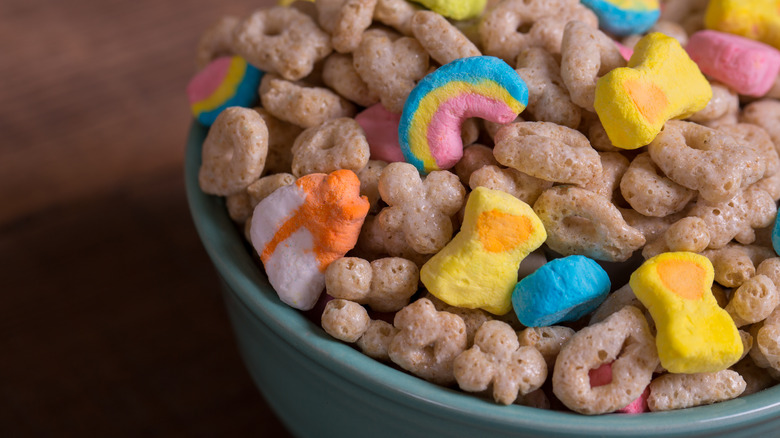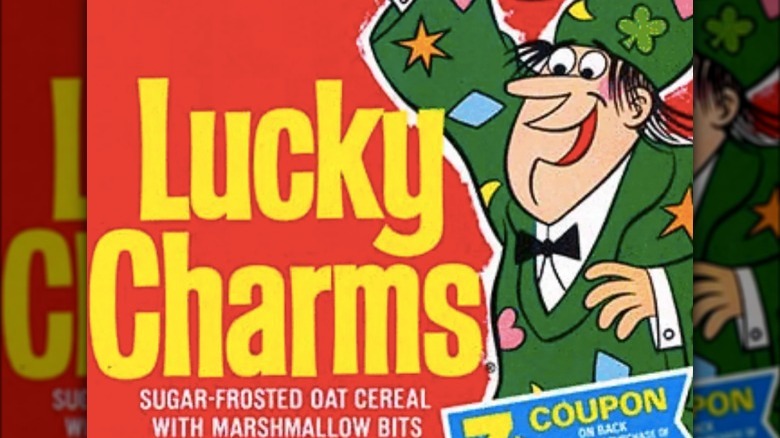The Rise And Immediate Fall Of Lucky Charms Mascot, Waldo
The rise of cereal in the early 20th century led to the rise of an arguably much bigger cultural icon: cereal mascots. Frosted Flakes has Tony the Tiger, Rice Krispies have Snap, Crackle, and Pop, Count Chocula has ... well, you get the idea. And one of the most iconic is Lucky, the lovable leprechaun spokesman for Lucky Charms. We may not be entirely sure what the Lucky Charms marshmallows are, exactly, but we eat them in part because we like the cut of that leprechaun's gib.
We take it as a given that Lucky the Leprechaun is the mascot for Lucky Charms, and it fits. A cheerful Irish sprite shilling colorful sugary cereal while talking about pots of gold? It feels obvious: luck, leprechaun — sure, that works.
But in the 1970s, General Mills decided to replace Lucky — in one region, at least — with a wizard named Waldo. And Waldo had a lot going on.
Waldo was constructed entirely of odd choices
There's no easy way to describe Waldo's deal other than saying he was A Lot. According to creator Alan Snedeker, Waldo's deal was "forgetfulness linked with wordplay" (via General Mills).
An unkempt wizard in a green robe and bowtie, Waldo was apparently designed to be flawed but relatable and kind. The basic framework of every commercial was that Waldo had lost his box of Lucky Charms and had to track it down. That aim makes sense; it's the "wordplay" angle that's a bit confusing. Waldo's trademark catchphrase was "ibble-debibble-delicious," which is less "wordplay" than it is random sounds.
Originally concocted in 1964 for a cereal named Amazin' Raisins that never got off the ground, Waldo was ultimately repurposed in the early 1970s for use in one specific market: New England. For a brief time in 1975, the two mascots even coexisted, with Waldo as the spokesman in the New England market and Lucky serving the same role everywhere else. There was at least a window where the possibility existed Lucky might replace Waldo entirely.
Why did General Mills change it in the first place?
General Mills came to Alan Snedeker because it had apparently started to feel that Lucky seemed cold and remote. He had all of these marshmallow treats but didn't want to share them with children. Snedeker tossed out Waldo and another mascot (a medieval armor-clad warrior called the Good Knight who jumped off cliffs) for the company's consideration.
The wild part is that Waldo (and the Good Knight, too) actually beat Lucky in comparative ad tests. So, why didn't Waldo replace Lucky entirely? The ultimate reason may be Snedeker's fault. After the company liked his designs, General Mills had Snedeker rework Lucky, too. Snedeker's vision made Lucky more friendly and less cold, turning the kids' chase for his Lucky Charms into more of a fun game than the odd bloodsport it had been.
Because General Mills had millions tied up in Lucky branding, it decided that although Waldo was testing well in New England, this new version of Lucky was easier to move forward with. So, Waldo was shuttered and Lucky came back — with most people totally unaware how close we came to never seeing that goofy little green suit again.


